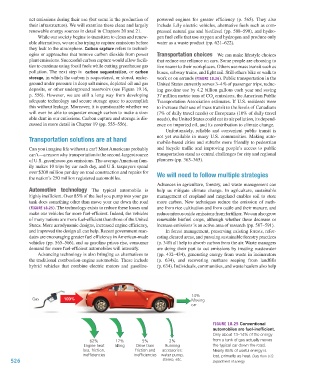Page 527 - Environment: The Science Behind the Stories
P. 527
net emissions during their use (but some in the production of powered engines for greater efficiency (p. 565). They also
their infrastructure). We will examine these clean and largely include fully electric vehicles, alternative fuels such as com-
renewable energy sources in detail in Chapters 20 and 21. pressed natural gas and biodiesel (pp. 588–590), and hydro-
While our society begins to transition to clean and renew- gen fuel cells that use oxygen and hydrogen and produce only
able alternatives, we are also trying to capture emissions before water as a waste product (pp. 621–622).
they leak to the atmosphere. Carbon capture refers to technol-
ogies or approaches that remove carbon dioxide from power Transportation choices We can make lifestyle choices
plant emissions. Successful carbon capture would allow facili- that reduce our reliance on cars. Some people are choosing to
ties to continue using fossil fuels while cutting greenhouse gas live nearer to their workplaces. Others use mass transit such as
pollution. The next step is carbon sequestration, or carbon buses, subway trains, and light rail. Still others bike or walk to
storage, in which the carbon is sequestered, or stored, under- work or on errands (Figure 18.26). Public transportation in the
ground under pressure in deep salt mines, depleted oil and gas United States currently serves 3–4% of passenger trips, reduc-
deposits, or other underground reservoirs (see Figure 19.16, ing gasoline use by 4.2 billion gallons each year and saving
p. 556). However, we are still a long way from developing 37 million metric tons of CO emissions, the American Public
2
adequate technology and secure storage space to accomplish Transportation Association estimates. If U.S. residents were
this without leakage. Moreover, it is questionable whether we to increase their use of mass transit to the levels of Canadians
will ever be able to sequester enough carbon to make a size- (7% of daily travel needs) or Europeans (10% of daily travel
able dent in our emissions. Carbon capture and storage is dis- needs), the United States could cut its air pollution, its depend-
cussed in more detail in Chapter 19 (pp. 555–556). ence on imported oil, and its contribution to climate change.
Unfortunately, reliable and convenient public transit is
Transportation solutions are at hand not yet available in many U.S. communities. Making auto-
mobile-based cities and suburbs more friendly to pedestrian
Can you imagine life without a car? Most Americans probably and bicycle traffic and improving people’s access to public
can’t—a reason why transportation is the second-largest source transportation stand as central challenges for city and regional
of U.S. greenhouse gas emissions. The average American fam- planners (pp. 363–365).
ily makes 10 trips by car each day, and U.S. taxpayers spend
over $200 million per day on road construction and repairs for We will need to follow multiple strategies
the nation’s 250 million registered automobiles.
Advances in agriculture, forestry, and waste management can
Automotive technology The typical automobile is help us mitigate climate change. In agriculture, sustainable
highly inefficient. Over 85% of the fuel you pump into your gas management of cropland and rangeland enables soil to store
tank does something other than move your car down the road more carbon. New techniques reduce the emission of meth-
(Figure 18.25). The technology exists to reduce these losses and ane from rice cultivation and from cattle and their manure, and
make our vehicles far more fuel-efficient. Indeed, the vehicles reduce nitrous oxide emissions from fertilizer. We can also grow
of many nations are more fuel-efficient than those of the United renewable biofuel crops, although whether these decrease or
States. More aerodynamic designs, increased engine efficiency, increase emissions is an active area of research (pp. 587–591).
and improved tire design all can help. Recent government man- In forest management, preserving existing forests, refor-
dates are encouraging greater fuel efficiency in American-made esting cleared areas, and pursuing sustainable forestry practices
vehicles (pp. 565–566), and as gasoline prices rise, consumer (p. 340) all help to absorb carbon from the air. Waste managers
demand for more fuel-efficient automobiles will intensify. are doing their part to cut emissions by treating wastewater
Advancing technology is also bringing us alternatives to (pp. 432–434), generating energy from waste in incinerators
the traditional combustion-engine automobile. These include (p. 634), and recovering methane seeping from landfills
hybrid vehicles that combine electric motors and gasoline- (p. 634). Individuals, communities, and waste haulers also help
14%
Gas 100% Moving
car
Figure 18.25 Conventional
automobiles are fuel-inefficient.
Only about 13–14% of the energy
62% 17% 5% 2% from a tank of gas actually moves
Engine heat Idling Drive train Running the typical car down the road.
loss, friction, friction and accessories: Nearly 85% of useful energy is
inefficiencies inefficiencies water pump, lost, primarily as heat. Data from U.S.
526 stereo, etc. Department of Energy.
M18_WITH7428_05_SE_C18.indd 526 12/12/14 4:05 PM

